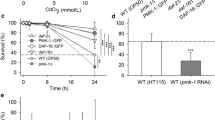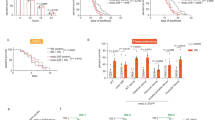Abstract
The p38 mitogen-activated protein kinase PMK-1 of Caenorhabditis elegans has been associated with heavy metal, oxidative and pathogen stress. Pmk-1 is part of an operon comprising three p38 homologues, with pmk-1 expression suggested to be regulated by the operon promoter. There are contradictory reports about the cellular localization of PMK-1. We were interested to study principles of pmk-1 expression and to analyze the role of PMK-1 under heat stress. Using a translational GFP reporter, we found pmk-1 expression to be driven by a promoter in front of pmk-1. PMK-1 was detected in intestinal cells and neurons, with a cytoplasmic localization at moderate temperature. Increasing temperature above 32 °C, however, induced a nuclear translocation of PMK-1 as well as PMK-1 accumulation near to apical membranes. Testing survival rates revealed 34–35 °C as critical temperature range, where short-term survival severely decreased. Mutants of the PMK-1 pathway (pmk-1Δ, sek-1Δ, mek-1Δ) as well as a mutant of JNK pathway (jnk-1Δ) showed significantly lower survival rates than wild-type or mutants of other pathways (kgb-1Δ, daf-2Δ). Rescue and overexpression experiments verified the negative effects of pmk-1Δ on heat tolerance. Studying gene expression by RNA-seq and semi-quantitative reverse transcriptase polymerase chain reaction revealed positive effects of the PMK-1 pathway on the expression of genes for chaperones, protein biosynthesis, protein degradation, and other functional categories. Thus, the PMK-1 pathway is involved in the heat stress responses of C. elegans, possibly by a PMK-1-mediated activation of the transcription factor SKN-1 and/or an indirect or direct PMK-1-dependent activation (hyperphosphorylation) of heat-shock factor 1.








Similar content being viewed by others
References
An JH, Vranas K, Lucke M, Inoue H, Hisamoto N, Matsumoto K, Blackwell TK (2005) Regulation of the Caenorhabditis elegans oxidative stress defense protein SKN-1 by glycogen synthase kinase-3. Proc Natl Acad Sci U S A 102(45):16275–16280
Audic S, Claverie JM (1997) The significance of digital gene expression profiles. Genome Res 7(10):986–995
Berman K, McKay J, Avery L, Cobb M (2001) Isolation and characterization of pmk-(1-3): three p38 homologs in Caenorhabditis elegans. Mol Cell Biol Res Commun 4(6):337–344. doi:10.1006/mcbr.2001.0300
Boellmann F, Guettouche T, Guo Y, Fenna M, Mnayer L, Voellmy R (2004) DAXX interacts with heat shock factor 1 during stress activation and enhances its transcriptional activity. Proc Natl Acad Sci U S A 101(12):4100–4105. doi:10.1073/pnas.0304768101
Bolz DD, Tenor JL, Aballay A (2010) A conserved PMK-1/p38 MAPK is required in Caenorhabditis elegans tissue-specific immune response to Yersinia pestis infection. J Biol Chem 285(14):10832–10840
Cully M, Genevet A, Warne P, Treins C, Liu T, Bastien J, Baum B, Tapon N, Leevers SJ, Downward J (2010) A role for p38 stress-activated protein kinase in regulation of cell growth via TORC1. Mol Cell Biol 30(2):481–495
Evans TC (2006) Transformation and microinjection. WormBook: 1–11. doi:10.1895/wormbook.1.108.1
Frydman J (2001) Folding of newly translated proteins in vivo: the role of molecular chaperones. Annu Rev Biochem 70:603–647
Guettouche T, Boellmann F, Lane WS, Voellmy R (2005) Analysis of phosphorylation of human heat shock factor 1 in cells experiencing a stress. BMC Biochem 6:4
GuhaThakurta D, Palomar L, Stormo GD, Tedesco P, Johnson TE, Walker DW, Lithgow G, Kim S, Link CD (2002) Identification of a novel cis-regulatory element involved in the heat shock response in Caenorhabditis elegans using microarray gene expression and computational methods. Genome Res 12(5):701–712. doi:10.1101/gr.228902
Hageman J, Rujano MA, van Waarde MAWH, Kakkar V, Dirks RP, Govorukhina N, Oosterveld-Hut HMJ, Lubsen NH, Kampinga HH (2010) A DNAJB chaperone subfamily with HDAC-dependent activities suppresses toxic protein aggregation. Mol Cell 37(3):355–369. doi:10.1016/j.molcel.2010.01.001
Henderson ST, Johnson TE (2001) daf-16 integrates developmental and environmental inputs to mediate aging in the nematode Caenorhabditis elegans. Curr Biol 11(24):1975–1980
Hoogewijs D, Houthoofd K, Matthijssens F, Vandesompele J, Vanfleteren JR (2008) Selection and validation of a set of reliable reference genes for quantitative sod gene expression analysis in Caenorhabditis elegans. BMC Mol Biol 9:9. doi:10.1186/1471-2199-9-9
Hsu AL, Murphy CT, Kenyon C (2003) Regulation of aging and age-related disease by DAF-16 and heat-shock factor. Science 300(5622):1142–1145. doi:10.1126/science.1083701
Huang P, Pleasance ED, Maydan JS, Hunt-Newbury R, O’Neil NJ, Mah A, Baillie DL, Marra MA, Moerman DG, Jones SJ (2007) Identification and analysis of internal promoters in Caenorhabditis elegans operons. Genome Res 17(10):1478–1485
Huang DW, Sherman BT, Lempicki RA (2009a) Systematic and integrative analysis of large gene lists using DAVID bioinformatics resources. Nat Protoc 4(1):44–57. doi:10.1038/nprot.2008.211
Huang DW, Sherman BT, Lempicki RA (2009b) Bioinformatics enrichment tools: paths toward the comprehensive functional analysis of large gene lists. Nucleic Acids Res 37(1):1–13. doi:10.1093/nar/gkn923
Inoue H, Hisamoto N, An JH, Oliveira RP, Nishida E, Blackwell TK, Matsumoto K (2005) The C. elegans p38 MAPK pathway regulates nuclear localization of the transcription factor SKN-1 in oxidative stress response. Genes Dev 19(19):2278–2283
Iser WB, Wilson MA, Wood WH 3rd, Becker K, Wolkow CA (2011) Co-regulation of the DAF-16 target gene, cyp-35B1/dod-13, by HSF-1 in C. elegans dauer larvae and daf-2 insulin pathway mutants. PLoS One 6(3):e17369. doi:10.1371/journal.pone.0017369
Jia K, Chen D, Riddle DL (2004) The TOR pathway interacts with the insulin signaling pathway to regulate C. elegans larval development, metabolism and life span. Development 131(16):3897–3906. doi:10.1242/dev.01255
Kahn NW, Rea SL, Moyle S, Kell A, Johnson TE (2008) Proteasomal dysfunction activates the transcription factor SKN-1 and produces a selective oxidative-stress response in Caenorhabditis elegans. Biochem J 409(1):205–213
Kenyon C, Chang J, Gensch E, Rudner A, Tabtiang R (1993) A C. elegans mutant that lives twice as long as wild type. Nature 366(6454):461–464. doi:10.1038/366461a0
Kim DH, Feinbaum R, Alloing G, Emerson FE, Garsin DA, Inoue H, Tanaka-Hino M, Hisamoto N, Matsumoto K, Tan MW, Ausubel FM (2002) A conserved p38 MAP kinase pathway in Caenorhabditis elegans innate immunity. Science 297(5581):623–626. doi:10.1126/science.1073759
Kondo M, Yanase S, Ishii T, Hartman PS, Matsumoto K, Ishii N (2005) The p38 signal transduction pathway participates in the oxidative stress-mediated translocation of DAF-16 to Caenorhabditis elegans nuclei. Mech Ageing Dev 126(6–7):642–647
Kramer JM, French RP, Park EC, Johnson JJ (1990) The Caenorhabditis elegans rol-6 gene, which interacts with the sqt-1 collagen gene to determine organismal morphology, encodes a collagen. Mol Cell Biol 10(5):2081–2089
Kubota H (2002) Function and regulation of cytosolic molecular chaperone CCT. Vitam Horm 65:313–331
Kültz D (2003) Evolution of the cellular stress proteome: from monophyletic origin to ubiquitous function. J Exp Biol 206:3119–3124
Kültz D (2005) Molecular and evolutional basis of the cellular stress response. Annu Rev Physiol 67:225–257. doi:10.1146/annurev.physiol.67.040403.103635
Laufen T, Mayer MP, Beisel C, Klostermeier D, Mogk A, Reinstein J, Bukau B (1999) Mechanism of regulation of hsp70 chaperones by DnaJ cochaperones. Proc Natl Acad Sci U S A 96(10):5452–5457
Lin K, Hsin H, Libina N, Kenyon C (2001) Regulation of the Caenorhabditis elegans longevity protein DAF-16 by insulin/IGF-1 and germline signaling. Nat Genet 28(2):139–145. doi:10.1038/88850
Lithgow GJ, White TM, Hinerfeld DA, Johnson TE (1994) Thermotolerance of a long-lived mutant of Caenorhabditis elegans. J Gerontol 49(6):B270–B276
McElwee JJ, Bubb K, Thomas JH (2003) Transcriptional outputs of the Caenorhabditis elegans forkhead protein DAF-16. Aging Cell 2(2):111–121. doi:10.1046/j.1474-9728.2003.00043.x
Mello CC, Kramer JM, Stinchcomb D, Ambros V (1991) Efficient gene transfer in C. elegans: extrachromosomal maintenance and integration of transforming sequences. EMBO J 10(12):3959–3970
Mizuno T, Hisamoto N, Terada T, Kondo T, Adachi M, Nishida E, Kim DH, Ausubel FM, Matsumoto K (2004) The Caenorhabditis elegans MAPK phosphatase VHP-1 mediates a novel JNK-like signaling pathway in stress response. EMBO J 23(11):2226–2234. doi:10.1038/sj.emboj.7600226
Morimoto RI (1998) Regulation of the heat shock transcriptional response: cross talk between a family of heat shock factors, molecular chaperones, and negative regulators. Genes Dev 12(24):3788–3796
Mortazavi A, Williams BA, McCue K, Schaeffer L, Wold B (2008) Mapping and quantifying mammalian transcriptomes by RNA-Seq. Nat Methods 5(7):621–628
Murphy CT (2006) The search for DAF-16/FOXO transcriptional targets: approaches and discoveries. Exp Gerontol 41(10):910–921
Murphy CT, McCarroll SA, Bargmann CI, Fraser A, Kamath RS, Ahringer J, Li H, Kenyon C (2003) Genes that act downstream of DAF-16 to influence the lifespan of Caenorhabditis elegans. Nature 424(6946):277–283. doi:10.1038/nature01789
Parag HA, Raboy B, Kulka RG (1987) Effect of heat shock on protein degradation in mammalian cells: involvement of the ubiquitin system. EMBO J 6(1):55–61
Raingeaud J, Gupta S, Rogers JS, Dickens M, Han J, Ulevitch RJ, Davis RJ (1995) Pro-inflammatory cytokines and environmental stress cause p38 mitogen-activated protein kinase activation by dual phosphorylation on tyrosine and threonine. J Biol Chem 270(13):7420–7426
Richter K, Haslbeck M, Buchner J (2010) The heat shock response: life on the verge of death. Mol Cell 40(2):253–266
Sagasti A, Hisamoto N, Hyodo J, Tanaka-Hino M, Matsumoto K, Bargmann CI (2001) The CaMKII UNC-43 activates the MAPKKK NSY-1 to execute a lateral signaling decision required for asymmetric olfactory neuron fates. Cell 105(2):221–232
Sakaguchi A, Matsumoto K, Hisamoto N (2004) Roles of MAP kinase cascades in Caenorhabditis elegans. J Biochem 136(1):7–11. doi:10.1093/jb/mvh097
Sheridan DL, Kong Y, Parker SA, Dalby KN, Turk BE (2008) Substrate discrimination among mitogen-activated protein kinases through distinct docking sequence motifs. J Biol Chem 283(28):19511–19520
Shivers RP, Pagano DJ, Kooistra T, Richardson CE, Reddy KC, Whitney JK, Kamanzi O, Matsumoto K, Hisamoto N, Kim DH (2010) Phosphorylation of the conserved transcription factor ATF-7 by PMK-1 p38 MAPK regulates innate immunity in Caenorhabditis elegans. PLoS Genet 6(4):e1000892. doi:10.1371/journal.pgen.1000892
Stiernagle T (2006) Maintenance of C. elegans. WormBook :1–11. doi:10.1895/wormbook.1.101.1
Tanaka-Hino M, Sagasti A, Hisamoto N, Kawasaki M, Nakano S, Ninomiya-Tsuji J, Bargmann CI, Matsumoto K (2002) SEK-1 MAPKK mediates Ca2+ signaling to determine neuronal asymmetric development in Caenorhabditis elegans. EMBO Rep 3(1):56–62. doi:10.1093/embo-reports/kvf001
Troemel ER, Chu SW, Reinke V, Lee SS, Ausubel FM, Kim DH (2006) p38 MAPK regulates expression of immune response genes and contributes to longevity in C. elegans. PLoS Genet 2(11):e183
Wang S, Tang M, Pei B, Xiao X, Wang J, Hang H, Wu L (2008) Cadmium-induced germline apoptosis in Caenorhabditis elegans: the roles of HUS1, p53, and MAPK signaling pathways. Toxicol Sci 102(2):345–351
Welker S, Rudolph B, Frenzel E, Hagn F, Liebisch G, Schmitz G, Scheuring J, Kerth A, Blume A, Weinkauf S, Haslbeck M, Kessler H, Buchner J (2010) Hsp12 is an intrinsically unstructured stress protein that folds upon membrane association and modulates membrane function. Mol Cell 39(4):507–520
Wolf M, Nunes F, Henkel A, Heinick A, Paul RJ (2008) The MAP kinase JNK-1 of Caenorhabditis elegans: location, activation, and influences over temperature-dependent insulin-like signaling, stress responses, and fitness. J Cell Physiol 214(3):721–729. doi:10.1002/jcp.21269
Wood CD, Thornton TM, Sabio G, Davis RA, Rincon M (2009) Nuclear localization of p38 MAPK in response to DNA damage. Int J Biol Sci 5(5):428–437
Acknowledgments
We thank Frank Nunes, Daniel Runde, and Ulrike Gigengack for supporting material and measurements, the Caenorhabditis Genetics Center for providing C. elegans strains, and the Deutsche Forschungsgemeinschaft for financial support (Pa 308/13-1).
Author information
Authors and Affiliations
Corresponding author
Rights and permissions
About this article
Cite this article
Mertenskötter, A., Keshet, A., Gerke, P. et al. The p38 MAPK PMK-1 shows heat-induced nuclear translocation, supports chaperone expression, and affects the heat tolerance of Caenorhabditis elegans. Cell Stress and Chaperones 18, 293–306 (2013). https://doi.org/10.1007/s12192-012-0382-y
Received:
Revised:
Accepted:
Published:
Issue Date:
DOI: https://doi.org/10.1007/s12192-012-0382-y




